June 17, 2025 | 00:55 GMT +7
June 17, 2025 | 00:55 GMT +7
Hotline: 0913.378.918
June 17, 2025 | 00:55 GMT +7
Hotline: 0913.378.918
Passion fruit trees are most suitable for growing on yellow-red or brown basalt soil, rich in humus, rich in nutrients, and with convenient irrigation (avoid growing passion fruit on soils that are prone to flooding and steep hills over 20 degrees). The field needs to be plowed 20 - 25cm deep, raised beds 3.0 - 3.5m wide, 0.2 - 0.25m high and all plant residue collected and destroyed. Then dig a hole in the middle of the bed, 60cm long, wide and deep, ensuring a planting density of 800 - 1,000 plants/ha. Plant the passion fruit gourd side level with the bed surface and cover the tree's root collar, lightly compress, cover the roots and water thoroughly.
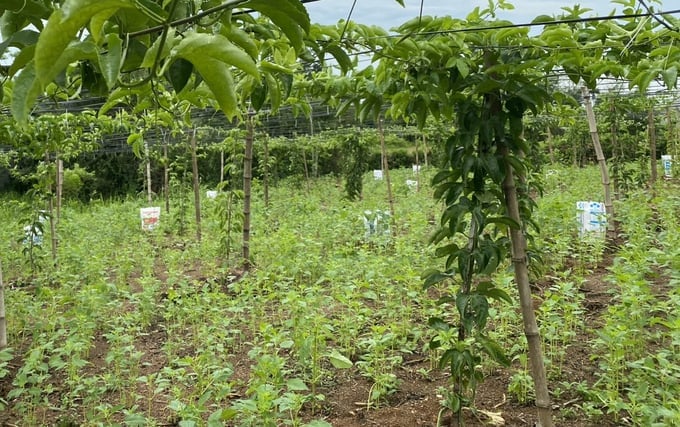
New passion fruit garden on trellis. Photo: Hai Tien.
Northern midland and mountainous provinces should plant passion fruit at the beginning of the rainy season (May - June), places with proactive water sources can grow it all year round.
There are many ways to make a trellis for passion fruit, but the simplest is to make it in the style of a luffa trellis, using concrete poles or sturdy bamboo or wood as pillars. The columns are 10 - 20cm in diameter, 2.6 - 2.8m long, buried about 60 - 80cm deep into the ground, 4 - 5m apart. The corner columns must have ropes on both sides to prevent the truss from falling. The width of the trellis depends on the passion fruit growing area. Use 3 - 4mm diameter steel wire to tie the ends of the columns together. Then use 1.5 - 2mm diameter steel wire to stretch horizontally and vertically to create cells on the truss with an area of 0.8 - 1m2.
When the passion fruit trees begin to climb the trellis, use 4cm diameter bamboo stakes to support each tree, keeping the passion fruit trellis sturdy. During the period when passion fruit produces many fruits, growers can add additional poles in the space between the main columns or at key positions of the trellis.
Fertilizer for 1 hectare/16 - 18 month cycle includes: Lime powder 1,000kg, microbial organic fertilizer 3,000kg, Van Dien fused phosphate fertilizer 1,000kg, Urea nitrogen 550kg, Potassium Chloride 1,700kg. Apply 100% of lime powder before soil preparation; line the hole before planting with the entire amount of microbial organic fertilizer and phosphate fertilizer. First top dressing (2 months after planting): 50kg Urea + 300kg potassium; second top dressing (4 months after planting) 100kg Urea + 300kg potassium; the third time (last time) about 5 months after planting (when the passion fruit begins to bear fruit), apply all the remaining fertilizer but divide the fertilizer into 2 times, 20 days apart.
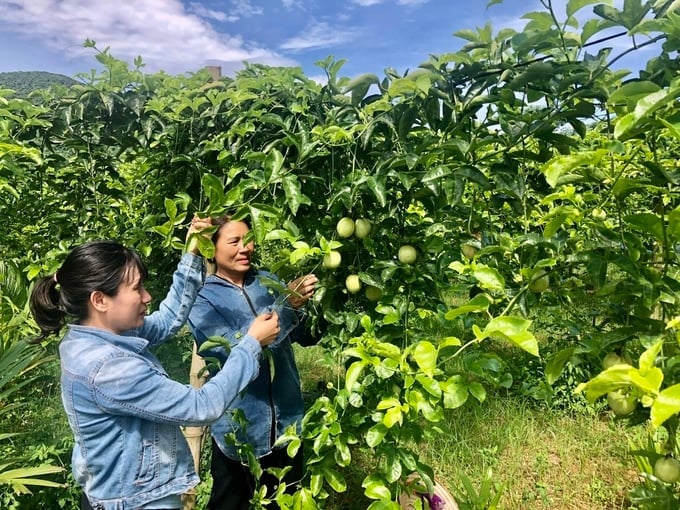
Passion fruit grown in Ngoc Luong Cooperative (Yen Thuy district, Hoa Binh province). Photo: Hai Tien.
How to fertilize: Dig a trench 1 - 1.2m from the root, then mix the fertilizers together, spread into the trench, cover with soil and water. Note, the next fertilizer application must not overlap the position where the previous fertilizer was applied. Regularly pull out weeds and water the garden when the weather is dry. When passion fruit trees climb trellises, fertilization, weeding and pruning should be combined to help the tree quickly branch, flower and fruit at a high rate.
In passion fruit production, pruning and canopy formation are very important techniques that determine whether the fruit yield is high or low. When the tree is not yet on the trellis, it is necessary to remove all the axillary buds, leaving only one main stem, and use a soft nylon string to tie the tree top up to the trellis.
When the passion fruit tree is 20 - 25cm from the top of the trellis pole, press the top and stop pruning the axillary buds so that the tree can produce first-level branches. Then choose to keep on each tree 5-6 healthy, pest-free, level 1 branches, evenly distributed in all directions of the trellis. When the level 1 branch reaches about 1m long, continue to press the tips to create level 2, 3 and 4 branches. In particular, only leave on the trellis the main branches (level 1; 2) that follow the wire, and the secondary branches (level 2; 3 and 4) hanging below the ground.
When the passion fruit tree has fruit, choose to grow 5-6 large, balanced passion fruit on each branch. Other fruits need to be cut off along with old leaves, leaves with severe pests and diseases, or leaves that grow too dense. At the same time, prune ineffective branches (no fruit, no flowers or no flowers or fruit...) and cut off the tops of branches that hang down at the bottom 2 leaf nodes of the passion fruit. This pruning is done when the tree begins to produce fruit (4-5 months after planting).
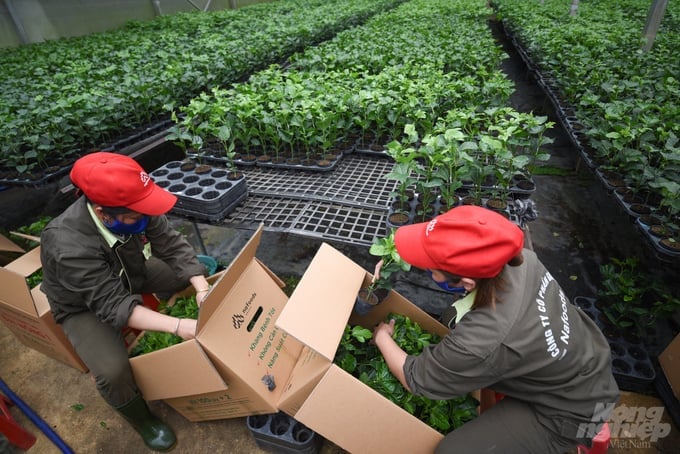
It is necessary to choose passion fruit varieties from reputable units and businesses with a certificate of origin. Photo: Vo Viet.
After each fruit harvest, continue to prune all fruit-bearing branches, stunted branches, diseased branches, old branches, branches hanging close to the ground, the cutting position is about 10cm from the base of the branch.
When the fruit harvesting season ends at the end of the year, all branches hanging below the trellis and level 3 and 4 branches on the surface of the trellis must be cut down at a position close to the branching point or steel wire trellis so that the tree sprout new branches for the next crop. After pruning, the plant residues that have just been cut must be collected and thoroughly incinerated. Note that the passion fruit tree grows and develops very well. Pruning needs to be done periodically every week to stimulate the tree to produce many branches and produce many fruits because passion fruit produces fruit from the branches.
Passion fruit trees need a lot of water, especially during the flowering and fruit-bearing stages. If possible, install a sprinkler or drip irrigation system for the garden. If growers irrigate furrows, they need to let the water penetrate evenly onto the bed surface, ensuring the garden soil is always moist enough throughout the plant's growth and development. However, passion fruit trees are also very afraid of flooding. It is necessary to promptly monitor drainage for the garden during the rainy season, absolutely not allowing flooding to occur, including local flooding.
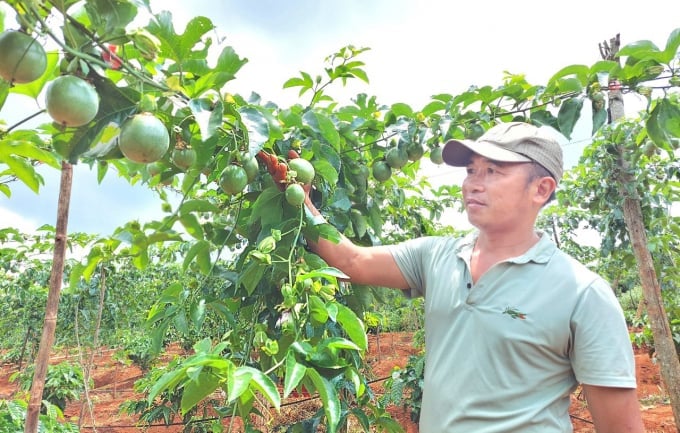
Passion fruit is a plant susceptible to many diseases, so it is necessary to focus on disease prevention according to the integrated pest management (IPM) process on fruit trees. Photo: NNVN.
Passion fruit trees suffer from many types of pests and diseases, including diseases caused by viruses, bacteria, and harmful nematodes such as root rot, wilting, hardening of the fruit's skin... and there is no specific pesticide. To prevent, it is necessary to strictly follow the integrated pest management - IPM process on fruit trees, pay attention to choosing seedlings with good disease resistance, and regularly prune to create ventilation for the passion fruit trellis. Apply correct and adequate amounts of lime powder, do not rotate crops, intercrop passion fruit with herbaceous vines, spray promptly to eliminate vectors that transmit viral diseases such as aphids. Only use pesticides on the state list allowed for use on safe fruits and vegetables.
When the passion fruit peel turns from bright green to pinkish, it is best to pick the fruit that is physiologically ripe and the peel is purple. Passion fruit trees will be harvested about 4-5 months after planting, with 6-7 batches of fruit harvested each year.
Passion fruit can be intercropped with peanuts and soybeans between rows of stakes to increase income as well as improve soil and increase production efficiency. Applying these technical solutions, Ngoc Luong Cooperative in Yen Thuy district, Hoa Binh province has grown passion fruit with a fruit yield of 40 tons/ha, with a harvest value of nearly 19,200 USD/hectare of cultivation.
Translated by Phuong Linh
![Turning wind and rain into action: [4] Bringing climate bulletins to remote and isolated areas](https://t.ex-cdn.com/nongnghiepmoitruong.vn/608w/files/linhnhp/2025/06/14/1152-z6704423696987_15fd32ffc26d590d204d520c9dac6786-nongnghiep-151141.jpg)
(VAN) The Vietnam Agriculture and Nature Newspaper interviewed Mr. Vu Thai Truong, Acting Head of Climate Change and Environment at UNDP Vietnam, to gain deeper insight into how climate bulletins are delivered to farmers.

(VAN) In Tien Giang, a high-tech shrimp farm has developed a distinctive energy-saving farming model that has yielded promising results.
![Turning wind and rain into action: [3] 300.000 farmers benefit from agro-climatic bulletins](https://t.ex-cdn.com/nongnghiepmoitruong.vn/608w/files/news/2025/06/12/e5a48259d6a262fc3bb3-nongnghiep-125122.jpg)
(VAN) The agro-climatic bulletin has become a valuable tool for farmers in the Mekong Delta. After more than five years of implementation, the initiative is gradually being expanded nationwide.
![Turning wind and rain into action: [2] Providing forecasts to the people](https://t.ex-cdn.com/nongnghiepmoitruong.vn/608w/files/news/2025/06/12/e5a48259d6a262fc3bb3-nongnghiep-103927.jpg)
(VAN) In addition to improving the quality of hydrometeorological forecasts, putting forecast bulletins into practical use is crucial for production and disaster prevention.
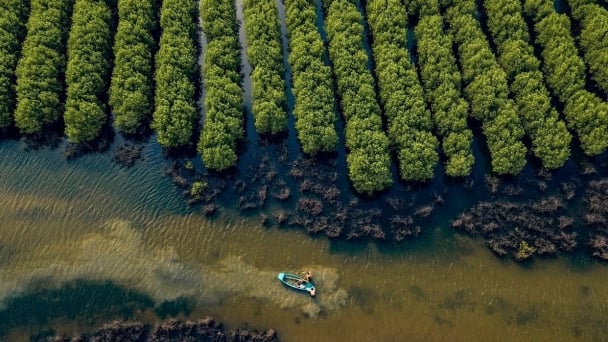
(VAN) Blue carbon is receiving attention for its rapid absorption capacity and vast potential. It represents a promising nature-based solution to respond to climate change.
/2025/06/11/3507-1-161904_583.jpg)
(VAN) Seagrass beds and coral reefs serve as 'cradles' that nurture life in the ocean depths, creating rich aquatic resources in Vietnamese waters.
![Turning wind and rain into action: [1] Forecasting for farmers](https://t.ex-cdn.com/nongnghiepmoitruong.vn/608w/files/news/2025/06/11/e5a48259d6a262fc3bb3-nongnghiep-111919.jpg)
(VAN) Weather is no longer just a matter of fate. Forecasts have now become an essential companion for farmers in every crop season.